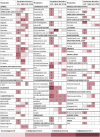Validated metabolomic biomarkers in psychiatric disorders: a narrative review
- PMID: 40634860
- PMCID: PMC12239260
- DOI: 10.1186/s10020-025-01258-7
Validated metabolomic biomarkers in psychiatric disorders: a narrative review
Abstract
Schizophrenia, major depressive disorder, bipolar disorder and posttraumatic stress disorder are severe and profoundly debilitating mental illnesses. Due to their heterogeneity and polygenic nature, the metabolic pathways and biological mechanisms underlying these conditions remain elusive. Consequently, diagnosing psychiatric disorders is a complex and multifaceted process, relying on clinical assessment and standardized diagnostic criteria. There is a growing demand to identify and integrate potential biomarkers for these disorders, especially for early diagnosis, to enhance diagnostic accuracy and complement existing diagnostic tools. Validating potential diagnostic biomarkers is essential to ensure their accuracy, reliability, generalizability, and clinical utility.In this article we provide a comprehensive review of validated metabolomics research, focusing on both the specific psychiatric conditions and the types of validation performed. Our scope is limited to peer-reviewed studies that include studies that performed validation studies in independent cohorts, cross-validation, or external validation. Due to the lack of published research, most of these validation studies have concentrated on major depressive disorder and schizophrenia, with fewer studies addressing bipolar disorder and posttraumatic stress disorder.Biomarkers are considered as validated if they demonstrated reproducibility in additional cohorts and biological relevance across independent datasets. However, several limitations must be acknowledged, including the heterogeneity in study design, small sample sizes, different analytical platforms, and inconsistent validation criteria across studies. Published results reveal that potential metabolomics biomarkers pertain to diverse categories pointing to a range of cellular, biological, and metabolic processes and emphasizing the intricate nature of psychiatric disorders. Such findings illustrate the formidable challenge of identifying and validating clinically useful metabolomic biomarkers and underscore the necessity for further research that encompasses various validation methodologies.
Keywords: Biomarkers; Metabolomics; Psychiatric disorders; Validation.
© 2025. The Author(s).
Conflict of interest statement
Declarations. Ethics approval and consent to participate: Not applicable. Consent for publication: Not applicable. Competing interests: The authors declare no competing interests.
Figures







References
-
- American Psychiatric Association. Diagnostic and statistical manual of mental disorders: DSM-5TM, 5th ed. Diagnostic and statistical manual of mental disorders: DSM-5TM. 5th ed. Arlington: American Psychiatric Publishing, Inc.; 2013. p. xliv, 947– xliv, 947.
Publication types
MeSH terms
Substances
Grants and funding
LinkOut - more resources
Full Text Sources
Medical

